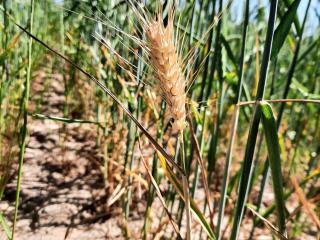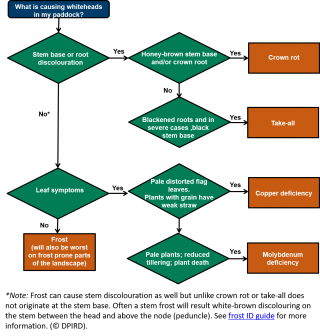Fusarium crown rot
- Nungarin
- Merredin
- Hyden
- Salmon Gums
DPIRD plant pathologists have recently found fusarium crown rot in wheat at Merredin and Nungarin, as well as in barley at Hyden. Additionally, crown rot was recently discovered in Maximus CL barley and Scepter wheat near Salmon Gums.
Crown rot mainly affects wheat and barley. It is caused predominately by Fusarium pseudograminearum. This is a stubble-borne fungus which infects plants at the crown through contact with infected stubble of cereals and/or grass weeds from previous seasons. The fungus can survive in infected stubble for several years. The infection reduces water supply to the stem, causing the premature hay-off of the heads known as whiteheads.

The bumper crops from the 2021 and 2022 seasons have resulted in a higher than usual infected stubble load in many paddocks, leading to an increased disease risk in 2023. Coupled with the hot, dry weather experienced in many areas of WA, there may be a high risk of whitehead expression and consequent increased yield loss risk in paddocks where the crown rot fungus is present. This risk is especially significant in low rainfall areas such as the eastern grainbelt.
Infected tillers of plants may show whiteheads that fail to fill grain in seasons with a dry finish. In severe cases, the entire plant develops whiteheads. While whiteheads may not develop in paddocks where plenty of water is available to the plant, they can still be seen in areas with soil compaction, such as tracks or around trees.
The disease also shows distinctive honey-brown discolouration of the stem base or lower node when leaf sheaths are removed. The honey-brown discolouration distinguishes it from the whiteheads produced by take-all, which produces black roots and black stems in severe cases. Frost, copper and molybdenum deficiency can also produce whiteheads, but will not have the honey-brown discolouration at the base. Direct signs of the fungus may sometimes, but not always, be present on the crowns as a pink colouration, particularly if rainfall has been recently experienced.
With damaging frost events occurring this season, it is important to check crops and correctly determine the cause of whiteheads in the paddock. Crown rot symptoms can appear similar to that of frost, and both may occur in the same paddock. Crown rot can be distinguished from frost by the presence of the honey-brown discoloration of the stem base and/or crown. While frost will not have stem discolouration at the base of the plant, in some it can cause discolouration further up the stem of the plant. Plant samples can be collected in a large 'W' pattern for stem assessment to determine the level of crown rot present as outlined in GRDC’s Crown rot – Western fact sheet. For more tips on distinguishing between whitehead causes, refer to the flow chart below.
The leadup to harvest is an important time to monitor crops and identify fusarium crown rot to assist planning to minimise its impact next year.
Crop rotation to non-cereals with good grass weed control is the key to management of affected paddocks. This is because there are currently no in-crop fungicides registered to address crown rot. Therefore, paddock management decisions based on this year’s observations will be critical to next year’s cropping program.
If a paddock with a high level of crown rot inoculum present is to be sown to cereals, then choose an appropriate barley or wheat variety with less yield loss to the disease. Information on varietal responses in yield have been provided in DPIRD’s 2023 Sowing Guide for WA.
Seed dressing, in combination with other management tools, can be used to minimise the initial infections. For more information refer to GRDC’s Crown rot – Western fact sheet and DPIRD's seed dressing and in-furrow fungicides for cereals in Western Australia page, which is updated annually.
Growers with whiteheads or other patchy, poor growth in barley and wheat paddocks are advised to check for the presence of the disease and confirm suspected infections by taking plant samples now or a soil sample with added stubble after harvest. Plant samples can be dispatched to the DPIRD Diagnostic Laboratory Services – Plant pathology lab to confirm what soilborne disease they may be dealing with. The PREDICTA® B soil test can detect the presence of the crown rot fungus in soil samples to which stubble samples have been added as recommended in the PREDICTA B sampling protocol as well as several other soilborne pathogens including take-all, rhizoctonia bare-patch and some types of parasitic nematodes.
For more details on crown rot refer to:
- DPIRD’s diagnosing crown rot of cereals page.
- GRDC's Crown rot – Western fact sheet.
- DPIRD’s 2018 Protecting WA Crops Snapshot: Identifying cereal root diseases issue.
- SoilsWest’s Soil Quality: 5 Soil Biology e-book. The Apple Books version includes information on crown rot and other soilborne diseases and nematodes.
Growers should also refer to DPIRD’s diagnosing take-all in cereals page. Note that this disease can sometimes be confused with crown rot.
For more information contact Research scientists Daniel Hüberli in South Perth on +61 (0)8 9368 3836 or +61 (0)427 426 522 or Kylie Chambers in Northam on +61 (0)8 9690 2151.
Article authors: Cindy Webster (DPIRD Narrogin), Daniel Huberli (DPIRD South Perth) and Kylie Chambers (DPIRD Northam).


